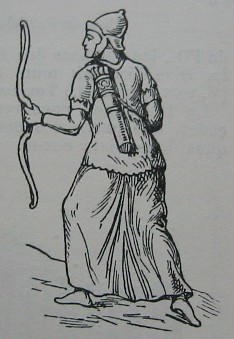
| PARNI
Parthian Warrior The Parni (Ancient Greek: Parnoi) or Aparni (Aparnoi) were an East Iranian people who lived around the Ochus (Ancient Greek: Okhos) (Tejen) River, southeast of the Caspian Sea. It is believed that their original homeland may have been southern Russia from where they emigrated with other Scythian tribes. The Parni were one of the three tribes of the Dahae confederacy.
In the middle of the 3rd century BCE, the Parni invaded Parthia, "drove away the Greek satraps, who had then only just acquired independence, and founded a new dynasty", that of the Arsacids.
Historical
identity and location :
The location of the Parni Dahae immediately south-east of the Caspian Sea was derived from by Strabo's Geographica (Book 11, 1st century BCE). The ethnonym of the Dahae was the root of the later placename Dahestan or Dihistan – a region straddling the present regions of Turkmenistan and Iran. So little is known of the Dahae, including the Parni, that – in the words of A. D. H. Bivar – even the location and name of their capital city "if indeed they possessed one" is now unknown. A later archaeological site in the region, known as Dehistan/Mishrian, is located in the Balkan Region of Turkmenistan.
Language
:
The language of the Parni "was described by Justin as 'midway between Scythian and Median [and] contained features of both'" (41.1.10). Justin's late (3rd century) opinion is "no doubt slightly exaggerated," and is in any case of questionable veracity given the ambiguity of names.
Rise
to prominence :
Meanwhile, "a man called Arsaces, of Scythian or Bactrian origin, [was] elected leader of the Parni tribes." Following the secession of Parthia from the Seleucid Empire and the resultant loss of Seleucid military support, Andragoras had difficulty in maintaining his borders, and about 238 BCE—under the command of "Arsaces and his brother Tiridates"—the Parni invaded Parthia and seized control of Astabene (Astawa), the northern region of that territory, the administrative capital of which was Kabuchan (Kuchan in the vulgate).
A short while later, the Parni seized the rest of Parthia from Andragoras, killing him in the process. Although an initial punitive expedition by the Seleucids under Seleucus II was not successful, the Seleucids under Antiochus III recaptured Arsacid-controlled territory following the Battle of Mount Labus in 209 BCE from Arsaces' (or Tiridates') successor, Arsaces II. Arsaces II sued for peace and accepted vassal status, and it was not until Arsaces II's grandson (or grand-nephew) Phraates I, that the Arsacids/Parni would again begin to assert their independence.
For the historiographers upon whose documentation the reconstruction of early Arsacid history depends, the Parni had by then become indistinguishable from the Parthians.
Legacy
:
The name "Parni" reappears in Sassanid-era documents to identify one of the seven Parthian feudal families allied with the Sassanid court. However, this family is not attested from Arsacid times, and the claim to the "Parni" name is (like four of the six other families) "in all probability not in accordance with reality." "It may be that members of them made up their own genealogies in order to emphasize the antiquity of their families."
It has been suggested that the Parnau Hills (Paran Koh) bear the name of the Parni.
Source :
https://en.wikipedia.org/ |
